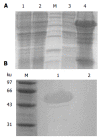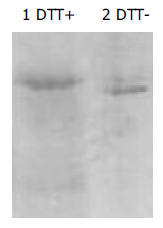Disulfide-stabilized single-chain antibody-targeted superantigen: construction of a prokaryotic expression system and its functional analysis
- PMID: 16097068
- PMCID: PMC4398746
- DOI: 10.3748/wjg.v11.i31.4899
Disulfide-stabilized single-chain antibody-targeted superantigen: construction of a prokaryotic expression system and its functional analysis
Abstract
Aim: To construct the expression vector of B3 (scdsFv)-SEA (D227A) and to identify its binding and cytotoxic ability to B3 antigen positive carcinoma cell lines.
Methods: This fusion protein was produced by a bacterial expression system in this study. It was expressed mainly in the inclusion body. The gene product was solubilized by guanidine hydrochloride, refolded by conventional dilution method, and purified using SP-sepharose cation chromatography.
Results: The expression vector B3 (scdsFv)-SEA-PET was constructed, the expression product existed mainly in the inclusion body, the refolding product retained the binding ability of the single-chain antibody and had cytotoxic effect on HT-29 colon carcinoma cells. The stability assay showed that the resulting protein was stable at 37 degrees.
Conclusion: This genetically engineered B3 (scdsFv)-SEA fusion protein has bifunction of tumor targeting and tumor cell killing and shows its promises as an effective reagent for tumor-targeted immunotherapy.
Figures






Similar articles
-
[Expression, purification, and characterization of single-chain disulfide-bond Fv (ScdsFv) antibody fused with targeted superantigen SEA (D227A)].Xi Bao Yu Fen Zi Mian Yi Xue Za Zhi. 2005 May;21(3):269-72. Xi Bao Yu Fen Zi Mian Yi Xue Za Zhi. 2005. PMID: 15862136 Chinese.
-
[Construction and activity analysis of a recombinant immunotoxin composed of PE38 and a disulfide stable single-chain antibody].Xi Bao Yu Fen Zi Mian Yi Xue Za Zhi. 2006 Jan;22(1):74-7. Xi Bao Yu Fen Zi Mian Yi Xue Za Zhi. 2006. PMID: 16388751 Chinese.
-
Improved stability and yield of Fv targeted superantigen by introducing both linker and disulfide bond into the targeting moiety.Biochimie. 2005 Aug;87(8):661-7. doi: 10.1016/j.biochi.2005.04.005. Biochimie. 2005. PMID: 15927340
-
[Construction and expression of recombinant prokaryotic expression vector for disulfide-stabilized anti-TeNT single-chain Fv antibody].Xi Bao Yu Fen Zi Mian Yi Xue Za Zhi. 2013 Jan;29(1):60-4. Xi Bao Yu Fen Zi Mian Yi Xue Za Zhi. 2013. PMID: 23294719 Chinese.
-
[The construction and expression of a hepatocellular carcinoma-specific superantigen SEA (D227A) expression vector].Xi Bao Yu Fen Zi Mian Yi Xue Za Zhi. 2003 Jul;19(4):353-6. Xi Bao Yu Fen Zi Mian Yi Xue Za Zhi. 2003. PMID: 15163383 Chinese.
References
-
- Kalland T, Dohlsten M, Abrahmsén L, Hedlund G, Björk P, Lando PA, Sundstedt A, Akerblom E, Lind P. Targeting of superantigens. Cell Biophys. 1993;22:147–164. - PubMed
-
- Pai LH, Batra JK, FitzGerald DJ, Willingham MC, Pastan I. Antitumor effects of B3-PE and B3-LysPE40 in a nude mouse model of human breast cancer and the evaluation of B3-PE toxicity in monkeys. Cancer Res. 1992;52:3189–3193. - PubMed
Publication types
MeSH terms
Substances
LinkOut - more resources
Full Text Sources

